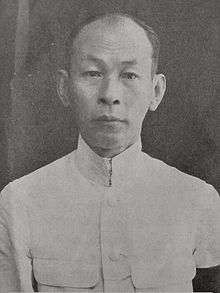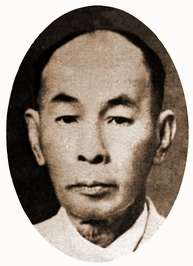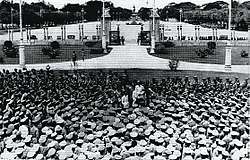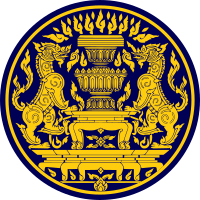Phraya Manopakorn Nititada
| Phraya Manopakorn Nititada | |
|---|---|
| พระยามโนปกรณ์นิติธาดา | |
 | |
| 1st Prime Minister of Siam | |
|
In office 28 June 1932 – 20 June 1933 | |
| Monarch | Prajadhipok |
| Preceded by | Position established |
| Succeeded by | Phraya Phahonphonphayuhasena |
| Finance Minister of Thailand | |
|
In office 10 December 1932 – 24 June 1933 | |
| Prime Minister | himself |
| Preceded by | Phraya Manopakorn Nititada (as Minister of Treasury) |
| Succeeded by | Chao Phraya Srithammatibet |
| Minister of Treasury | |
|
In office 29 June 1932 – 10 December 1932 | |
| Preceded by | Suphayok Kasem |
| Succeeded by | Phraya Manopakorn Nititada (as Finance Minister of Thailand) |
| Personal details | |
| Born |
15 July 1884 Bangkok, Siam |
| Died |
1 October 1948 (aged 64) Penang, British Malaya |
| Nationality | Thai |
| Political party | Khana Ratsadon |
| Spouse(s) |
Nit Sanasen (Deceased) Choei Hutasingha |
| Children | Tum Hutasingha |
Phraya Manopakorn Nititada (Thai: พระยามโนปกรณ์นิติธาดา; IPA: [pʰrá.jaː má.noː.pà.kɔːn ní.tì.tʰaː.daː]; born Kon Hutasingha (Thai: ก้อน หุตะสิงห์; IPA: [kɔ̂ːn hù.tà.sǐŋ]); 15 July 1884 – 1 October 1948) was the first Prime Minister of Siam after the Siamese Revolution of 1932 as he was selected by the leader of the People's Party – the party that instigated the revolution. However, in the following year, Manoparkorn was ousted by a coup in 1933 due to the conflicts between members of People's Party.
Early life

Kon Hutasingha was born on 15 July 1884 in Bangkok to Huad and Kaew Hutasingha (Thai: นายฮวด กับนางแก้ว หุตะสิงห์), both of whom were of Chinese extraction.[1] He received his primary education at Suankularb Wittayalai School in Bangkok. He pursued his law education at Assumption College and at the Law School of the Ministry of Justice. He then continued his studies abroad; at the Middle Temple, in London, England. After he had finished his education, he began to work for the Ministry of Justice and climbed the traditional career ladder and was eventually granted the title Phraya and received his honorary name: "Manopakorn Nititada". In 1918, he gained a seat in the Privy Council of King Vajiravudh (or Rama VI).
Revolution and Premiership

Following the Revolution of 1932, King Prajadhipok (or Rama VII) consented to a Provisional Constitution on 27 June 1932. The first People's Assembly of Siam, composed entirely of appointed members, met for the first time on 28 June. The revolutionary Khana Ratsadon not wanting to seem like had instigated the revolution for themselves decided to choose Phraya Manopakorn as President of the Committee. He was considered a largely neutral and clean figure, but at the same time respected enough to take the position.
As a result, the Assembly with the advice of Pridi Panomyong, one of the leaders of the Khana Ratsadon offered Manopakorn the post of "President of the People's Committee" - an early version of the post of Prime Minister.
The first mission of Phraya Manopakorn's Cabinet was to draft a permanent constitution. King Prajadhipok made an observation that the term "President of the People's Committee" sounded like a communist or republican post. After a debate, the office was eventually changed to "Prime Minister". The first constitution of Siam was promulgated under Phraya Manopakorn's watch on 10 December 1932 - now celebrated as the Thai Constitution Day.
Soon after Phraya Manopakorn became the Head of the first constitutional government of Siam. However the Manopakorn Cabinet or People's Committee was composed members; half from the People's Party and half from senior civil servants and military officers appointed under the guidance of the party. Phraya Manopakorn in essence became the Khana Ratsadon's puppet, and the country- a single party state.
Yellow Cover Dossier incident and Coup
In 1933, Pridi Panomyong, by then a Minister of State, presented his Draft Economic Plan or Yellow Cover Dossier to King Prajadhipok. The dossier was an economic plan, which advocated socialist solutions to the country's many financial and economic problem. Prajadhipok even branded the dossier "communist" and attacked Pridi publicly about it. After Pridi got his dossier rejected, his status fell and caused a major disruption among the members of People's Party and the People's Committee itself.
Phraya Mano rallied those who opposed the socialist plan of Pridi including Phraya Songsuradet and dissolve his own cabinet to try and oust Pridi, who had great support within the People's Party. To regain some stability and silence domestic critics, Phraya Manopakorn had some articles within the constitution suspended. Manopakorn barred the People's Assembly from any further meetings and the judiciary was shut down. Pridi was forced to flee to France. It was said that Manopakorn led the coup with his pen, this event is known in Thailand as the April 1933 Coup (or the Silent Coup) (Thai: รัฐประหารในประเทศไทย เมษายน พ.ศ. 2476). Phraya Manopakorn then approved the Anti-Communist Act, which allowed him powers to arrest those in society suspected of having communist sentiments (the entire Central Committee of the Communist Party of Siam was arrested and imprisoned).
After the Yellow Dossier Incident, the degree of political freedom was greatly reduced by Phraya Manopakorn's policies. He censored many leftist activities including shutting down of many newspapers and publications. However the People's Party which gave him the Premiership, will eventually be his downfall. On 16 June, Phraya Pahol Polpayuhasena (the county's most powerful military leader and member of the People's party) together with three other senior officers retired themselves from the People's Committee, for 'health reasons'.
- Further information Siamese coup d'état of 1933
Death and legacy
.jpg)
The coup d'état happened on 20 June, led by Phraya Pahol and other military leaders. Phraya Manopakorn was immediately removed as Prime Minister. Phraya Phahol appointed himself the country's second Prime Minister and took over the Government, King Pradhipok duly accepted his appointment. Manopakorn was then exiled to Penang, British Malaya, by train and spent the rest of his life there until his death in 1948, aged 64.
Not only was Phraya Manopakorn, Siam's first Prime Minister, he was also the first Siamese Prime Minister to be ousted by a coup. Especially significant is the fact that it was the military who removed him. Although he was the first, he would not be the last civilian Prime Minister to be ousted in a military coup. His legacy is debatable; on the one hand he took over the reins of government in an extremely difficult time (Wall Street Crash of 1929), but on the other he exceeded his powers and was not able to counter the powers of the Khana Ratsadon who became increasingly dictatorial.
See also
References
- ↑ Preston et al. (1997), p. 464; 51. Phya Manopakarana Nitidhada. He spoke perfect English and was always very friendly to England. Is three parts Chinese. His wife, who was a favourite lady-in-waiting to the ex-Queen, was killed in a motor accident in 1929 when on an official visit to Indo-China.
Bibliography
- Paul Preston, Michael Partridge, Antony Best, British Documents on Foreign Affairs--Reports and Papers from the Foreign Office Confidential Print, Volume 6, University Publications of America, 1997, ISBN 1-55655-674-8
| Political offices | ||
|---|---|---|
| New creation | Prime Minister of Thailand 1932-1933 |
Succeeded by Phraya Phahol Pholphayuhasena |
